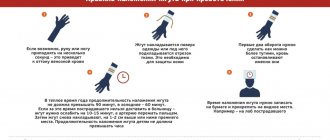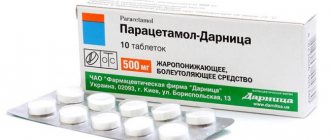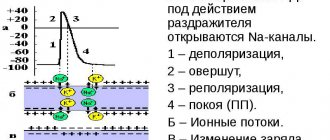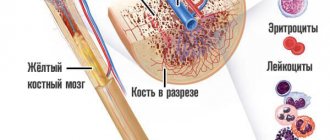Quickly and correctly provided first aid for bleeding is the key to a successful recovery of the victim.
The first aid algorithm depends on the type of bleeding. There are 4 types:
| Arterial | Represents the greatest danger. The blood flows quickly and is scarlet in color. |
| Venous | The blood flows out more slowly and is dark red in color. |
| Capillary | The blood comes out slowly and in a small volume, and has a bright red color. It may appear as small red drops on a person's skin. |
| Internal | The danger of this type of bleeding is that it is quite difficult to determine its presence in a person. Symptoms of internal bleeding depend on its location, most often the person becomes weak and pale, his pulse quickens (up to 140/min), he feels dizzy, has weak breathing, a swollen painful abdomen in the “embryo” position, and there may be a bruise on the abdomen. |
Causes of bleeding
The following factors can cause bleeding:
- mechanical damage to blood vessels;
- neoplasm or inflammatory process in the walls of blood vessels;
- deterioration of the integrity of blood vessels due to infection, lack of vitamins or poisoning of the body.
Remember that timely assistance with bleeding can save the victim’s life!
1 Help with bleeding. Types of bleeding
2 Help with bleeding. Types of bleeding
3 Help with bleeding. Types of bleeding
Internal bleeding in adults: symptoms, causes, treatment
The primary signs of internal bleeding are:
- weakness;
- drowsiness;
- blanching of mucous membranes and skin;
- dizziness;
- cold sweat;
- thirst;
- darkening of the eyes;
- changes in pulse and pressure - low-intensity blood loss is characterized by a slight increase in heart rate and a slight decrease in pressure.
Sometimes there are no clinical symptoms of internal bleeding.
The average severity of blood loss is reflected by tachycardia and a drop in pressure, while the patient feels dry mouth, nausea and dizziness, adynamia and severe weakness. The patient may faint.
Signs of severe bleeding:
- pressure drop up to 80 mm Hg. and increased pulsation to 110 or more beats per minute;
- uneven breathing and cold sweat;
- tremors in the hands and dark circles before the eyes;
- minimal amount of urine excreted;
- pallor and blueness of the skin and lips.
Massive bleeding and its signs:
- pressure drop up to 60 mm Hg. and increased heart rate to 140-160 beats per minute;
- frequency of breathing;
- confusion and delirium;
- sharply pale bluish-gray skin tones;
- absent look, sunken eyes.
How to identify fatal internal bleeding? According to the following signs: coma, lack of pressure, pulse 10 beats. per minute, convulsions and involuntary discharge of urine and feces begin, the pupils dilate, the skin becomes dry and cold. This condition turns into agony and leads to death.
Internal bleeding of the stomach and into the esophagus is accompanied by vomiting dark blood the color of coffee grounds. Tarry stool indicates blood leaking into the upper digestive system and small intestine. Internal abdominal bleeding is accompanied by irritation of the peritoneum and dull sounds in a flat area during palpation.
The leakage of blood into the lungs is accompanied by a cough with the release of foamy blood and its accumulation in the pleural cavity. Therefore, there is difficulty breathing and shortness of breath, as well as lack of air. Internal bleeding in women is the leakage of blood into the uterine or vaginal cavity.
The individual characteristics of each organism influence the severity of certain symptoms. Poorly expressed symptoms complicate the diagnostic process and worsen treatment prognoses.
Are you experiencing symptoms of internal bleeding?
Only a doctor can accurately diagnose the disease. Don't delay your consultation - call
Types of bleeding
The type of bleeding depends on which vessel is damaged, in which part of the body it is localized, and the intensity of blood loss.
Classification according to the type of damage to blood vessels:
- capillary bleeding;
- venous;
- internal (parenchymal);
- arterial;
- mixed bleeding.
Classification according to the cause of bleeding:
- abnormal bleeding;
- traumatic.
Classification according to the location of blood loss:
- external;
- internal.
Classification by volume of blood loss:
On average, about 5 liters of blood circulates in the body of an adult. Depending on the volume of fluid spilled, doctors distinguish the following degrees of blood loss:
- mild degree (less than 0.5 liters);
- medium (less than 1 liter);
- heavy (about 1.5 liters);
- massive (about 2.5 liters);
- lethal (about 3 liters), i.e. more than half of the total blood volume;
- absolutely lethal (more than 3.5 liters), i.e. above 60%.
First aid for bleeding is a system of therapeutic and preventive measures that must be taken in case of damage to blood vessels (arteries, capillaries and veins) until qualified medical assistance becomes available. Each type of bleeding has its own characteristics in providing assistance.
How to stop venous bleeding?
If there is bleeding from superficial veins, wash the wound with hydrogen peroxide and apply a tight bandage. To do this, apply a sterile napkin to the wound, place a tight wad of cotton wool on it and bandage it tightly in a circular motion. After applying a tight bandage, you should definitely consult a doctor. If the bandage becomes significantly saturated with blood and the bleeding does not stop, then damage to the deep veins should be assumed and a tourniquet should be applied.
Bleeding from the deep veins of the extremities, as well as the veins of the neck and head, requires urgent measures, since in a short period of time a person will lose a fairly large volume of blood. A decrease in circulating blood volume can lead to shock, acute kidney failure, and other life-threatening conditions.
If you suspect bleeding from deep veins, you should:
- Give the limb an elevated position;
- Apply a tourniquet;
- Apply an ice pack or a heating pad with cold water to the bleeding site;
- Deliver the victim to the clinic as soon as possible.
If the veins of the neck are damaged, the problem arises in clamping the bleeding vessel, because it is quite natural that a tourniquet cannot be used. If this condition is likely to develop, the person should be taken to hospital as soon as possible.
Emergency assistance includes the following measures:
- The bleeding vessel must be pinched with your fingers above and below the site of injury, if possible pressing it against the bone base;
- Use a napkin soaked in hydrogen peroxide to tightly clamp the wound, thereby preventing air from entering the bloodstream and the development of an air embolism;
- Apply cold to the bleeding site;
- Urgently transport the victim to the nearest hospital, where the vessel will be sutured.
In case of nosebleeds, a cotton swab moistened with hydrogen peroxide should be inserted into the nasal passage. Then press the wing of the nose to the bridge of the nose. To stop bleeding, you should not tilt your head back, especially if the victim is unconscious. This will cause blood to flow down the back of the throat and may enter the respiratory tract. To completely stop nosebleeds, apply a heating pad with cold water to the bridge of the nose or the back of the head for 3 minutes, then take a 3-minute break. Repeat until bleeding stops completely.
General rules of first aid for bleeding
If the victim has lost a significant amount of blood, try to lay him down and elevate his legs.
Do not touch the wound with your hands or remove glass shards from it.
If sand and rust get into the wound, do not wash the damage, as this will increase the bleeding.
If the wound becomes dirty, you need to carefully remove the dirt in the direction from the wound, then treat the cleaned edges with an antiseptic.
When treating the edges of a wound with an iodine solution, do not allow the antiseptic to get inside the wound.
Depending on the type of blood loss, try to stop the bleeding using a tourniquet, twisting, or squeezing the damaged vessel.
First aid for capillary bleeding
Bleeding from the capillaries is not accompanied by large blood loss and stops relatively quickly. A sign of capillary damage is the appearance of a gentle stream of blood on the wound.
First aid for this bleeding includes treating the edges of the wound with an alcohol antiseptic (iodine), on which an aseptic gauze bandage is applied. Please note that the bandage is not tight. Usually, with capillary bleeding, there is no need to go to the hospital, with the exception of situations where the damage is extensive.
1 First aid for bleeding
2 First aid for bleeding
3 First aid for bleeding
First aid for venous bleeding
A sign of venous bleeding is rapidly flowing dark blood. Its flow is uniform, without gushing or pulsating.
With venous bleeding, blood clots may appear; they cannot be removed, since in this case blood loss may increase.
To stop bleeding, apply a pressure aseptic bandage to the wound. If blood loss continues, it is necessary to apply a tourniquet below the damaged area. To reduce injury to soft tissues and skin, a soft pad is placed on them (under the tourniquet). It is necessary to make a note indicating the time of application of the tourniquet. The maximum time for wearing a tourniquet is 2 hours in warm weather and 1 hour at sub-zero temperatures. The tourniquet cannot be held longer than this time, otherwise the bloodless tissue will begin to die. If you don’t have a tourniquet, you can make twists from available materials: a bandage, a belt, a towel, a piece of fabric using a handle and a short stick. The time frame for the spins is the same. Try not to use any hemostatic drugs without a doctor's prescription.
First aid for arterial bleeding
Arterial bleeding is one of the most dangerous. The main sign of arterial damage is bright scarlet blood flowing out in a pulsating stream at high speed. If large arteries are damaged, the blood begins to flow intermittently, like a fountain.
First aid for this bleeding is to apply a hemostatic tourniquet above the level of the wound. You can also use a twist. Time restrictions are the same.
If there is no tourniquet or twist, you can stop the bleeding by pressing the artery above the damaged area with your finger, i.e. at the pulsation point.
In case of bleeding from the brachial, ulnar, femoral or popliteal artery, you can fix the arm or leg as bent as possible in an elevated position.
Stop bleeding
External bleeding is divided into three types:
- Arterial bleeding - scarlet blood flows from the wound in a pulsating stream
- Venous bleeding - dark blood flows from the wound in a uniform stream.
- Capillary bleeding - blood is released in drops or in the form of “dew”.
The most dangerous bleeding is arterial, because... it leads to rapid loss of a significant amount of blood and is not prone to stopping on its own.
The main task in providing first aid is to temporarily stop bleeding and transport the victim to a hospital, where he will be completely stopped by ligating the vessel, applying a vascular suture, electrocoagulation, etc.
A way to stop venous bleeding is to apply a tourniquet
Half the success of the fight against venous bleeding depends on the correct application of the tourniquet. Therefore, you should know how this measure of medical care is carried out.
- The tourniquet should be applied below the injury site, as close as possible to the wound itself.
- It is necessary to place a piece of bandage or fabric under the applied tourniquet to prevent damage to the skin.
- The tourniquet is applied by quickly wrapping the limb and tightening
- The exposure time of the tourniquet cannot exceed 1.5 hours, therefore, immediately after stopping the bleeding, the victim should be hospitalized as quickly as possible.
Bleeding in the veins of the neck
Bleeding in the veins of the neck
Why is damage to the veins in the neck dangerous?
- Without professional skills, it is impossible to apply a bandage without causing suffocation in the victim;
- vessels in the neck area are large in diameter, their injuries cause profuse and rapid blood loss, so first aid must be provided as quickly as possible;
- Air can be sucked into the lumen of a large vessel, resulting in the formation of an air plug (embolism), which can cause death.
How to stop bleeding if your neck is injured:
- Lay the person down so as to provide easy access to the wound.
- If possible, apply a cotton or gauze cloth folded several times and soaked in antiseptic (hydrogen peroxide) to the wound.
- Press the area above and below the injury with three fingers (ring, middle and index) of both hands folded together.
You can consider that you have achieved results if the bleeding has stopped or greatly weakened, but the pulsation of deep vessels is felt under your fingers.
Nose bleed
Prevention of bleeding from varicose veins
Modern prevention of bleeding from varicose veins consists of adequate and timely treatment of varicose veins. The leading specialist of the Moscow city phlebological center, Artyom Yuryevich Semyonov, helped hundreds of patients with developed bleeding from varicose veins, and helped thousands of patients avoid it. Modern medical technologies that are used in the city phlebology center can not only cure bleeding from varicose veins, but also prevent it. We use European innovations as efficiently as possible to preserve and maintain your health. The doors of our leading medical center in Moscow are open not only to residents of Moscow and the Moscow region, but also to any other region of our state.
Why is capillary bleeding dangerous for humans?
An important function of blood is to transport oxygen and nutrients. They are delivered to the tissues, and metabolic products and carbon dioxide are removed from there. With minor damage to the capillaries and shallow wounds there is no threat to health. However, with extensive capillary bleeding, this vital function is disrupted, resulting in possible oxygen deficiency. First of all, the heart muscle and nervous system suffer from oxygen starvation, which threatens life.
First aid for capillary bleeding is necessary not only in case of serious injuries, but also if blood comes from the nose, ear, gums, digestive tract, uterus and other organs.
The main distinguishing feature of capillary bleeding is the slow release of blood over the entire wound surface. There are two types of capillary bleeding: internal (the most dangerous of them are uterine, intestinal and gastric) and external.
Experts identify several causes of capillary bleeding, including traumatic, coagulopathic and pathological:
- Diseases of the blood coagulation system are hemophilia, thrombocytopenic purpura, von Willebrand disease;
- Traumatic injuries (abrasions, burns, cuts). According to the classification, they are divided into thermal, which arise from exposure to critically high temperatures, and mechanical, which occur in the event of various extreme situations (accidents, falls, fights);
- Vascular diseases in which damage to the skin and tissue occurs (tumors, purulent inflammation of the skin involving capillaries);
- General diseases (oncological processes, rheumatoid arthritis, multiple sclerosis, necrosis, atherosclerosis), which affect the vascular walls throughout the body. As a result, plasma and blood cells leak out and extensive internal capillary bleeding occurs;
- Hormonal dysfunctions.
Internal capillary bleeding over time can lead to the formation of interstitial and intra-articular hematomas. Such bleeding from parenchymal organs (liver, spleen, brain) if they are damaged poses a great danger.
Bleeding from varicose veins
Poor circulation can lead to varicose veins with the formation of blood clots. If the disease is not treated, complications will invariably arise that can be life-threatening. Along with varicose veins, varicose veins are formed - bubbles that have an uneven shape. Deformation and thinning of the wall of varicose veins often lead to the development of bleeding from varicose veins at the slightest trauma to the vessels. Bleeding from varicose veins occurs daily in patients in European countries, Moscow and the Moscow region. Leading specialists of both public and private city phlebological centers weekly face the problem of bleeding from varicose veins. Innovative technologies can easily prevent bleeding from varicose veins, but even the most advanced medical innovations are sometimes unable to save a person’s life if precious time is lost.











